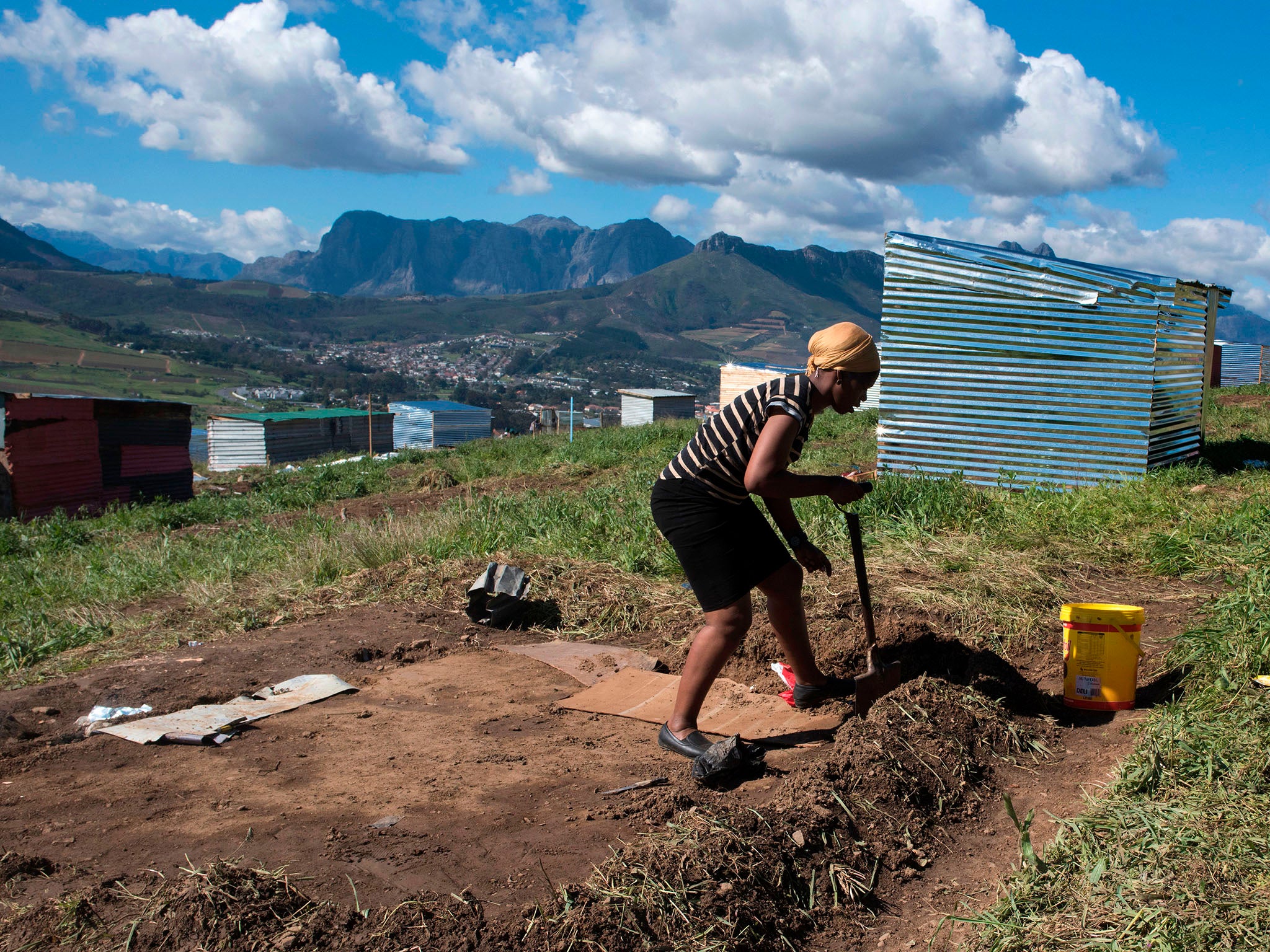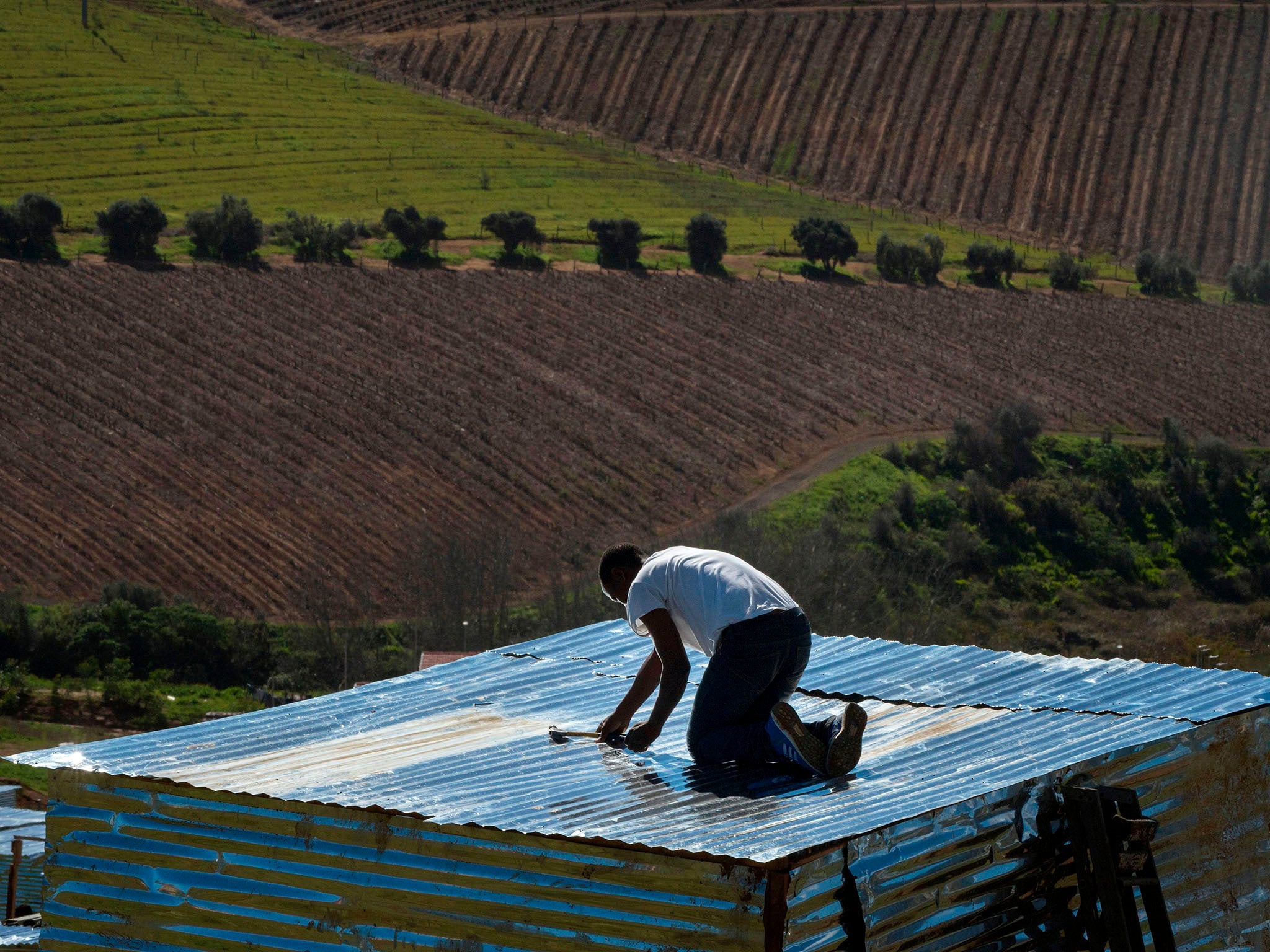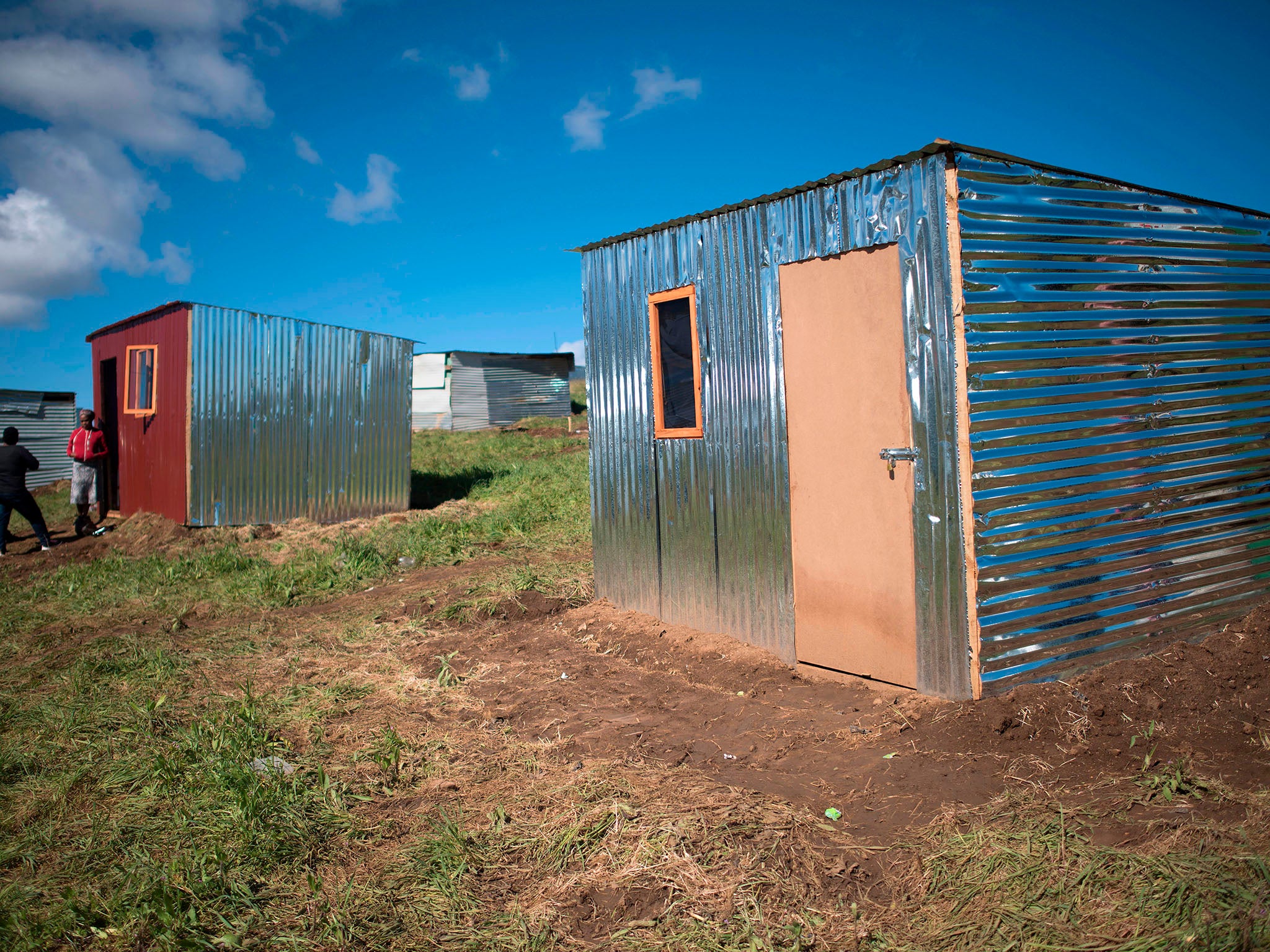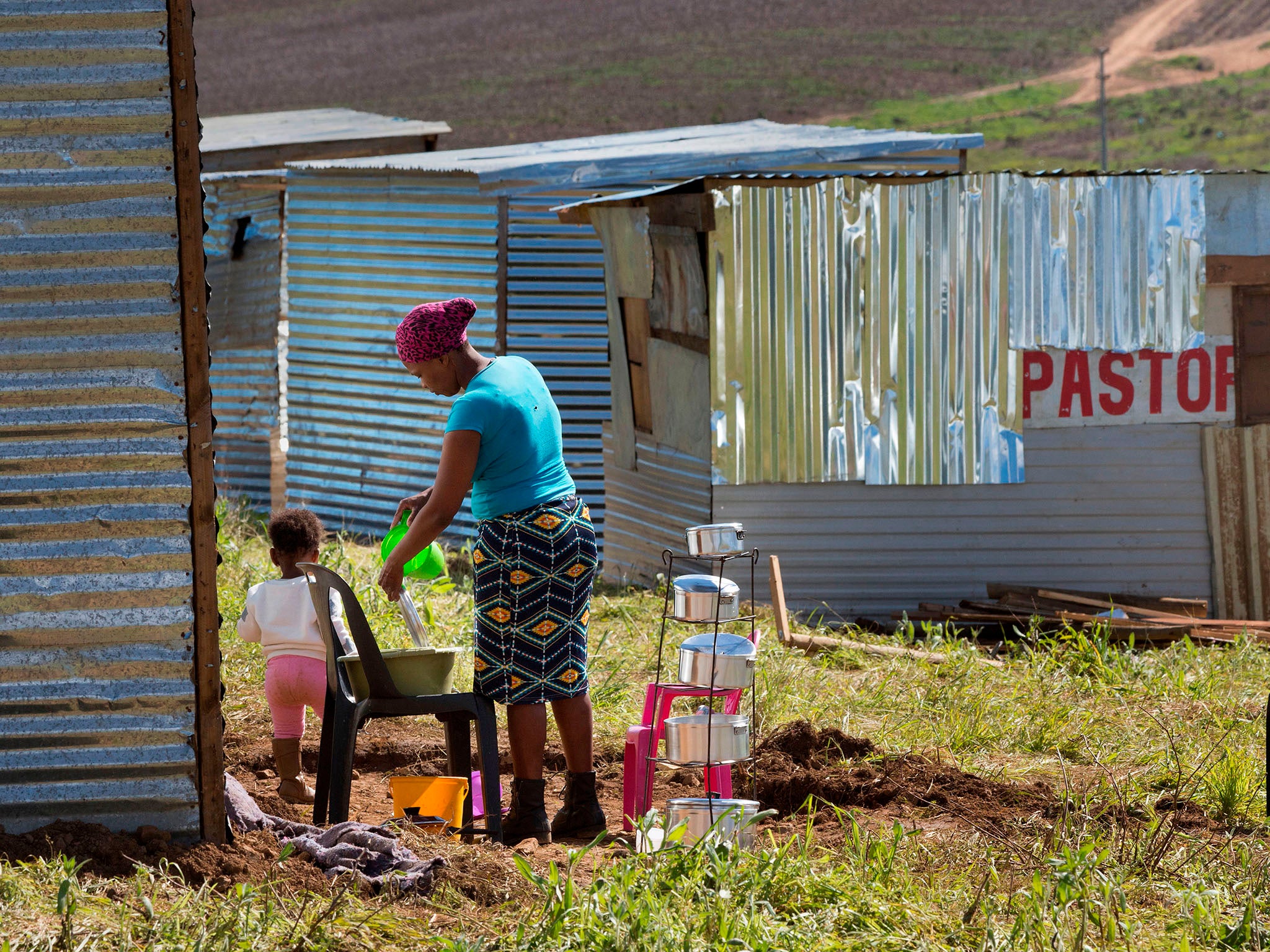In South Africa, vineyards are the battle ground in a tense racial dispute
Nearly 25 years after apartheid, some black people in South Africa find themselves without a home. So they’ve chosen to move into the white-owned vineyards, write Selam Gebrekidan and Norimitsu Onishi

One cold morning, Stefan Smit, a white farmer in South Africa’s stunning wine region, woke up to find his vineyard under siege.
Anxious and angry, Smit, 62, drove his pickup to the highest point on his estate and peered down. Impoverished residents from the black township next door had stormed the land, clearing weeds and erecting 40 shacks in a matter of hours.
“I, personally, can’t breathe here,” Smit says later.
Virtually overnight, Smit’s farm, with its sweeping views of the Stellenbosch region, became a battleground in a bitter political fight that has split the nation and reached all the way to the Trump White House: who should own South Africa’s land?
The fight pits white South Africans, who still control much of the economy a generation after the end of apartheid, directly against their black neighbours, many of whom are struggling to acquire a tiny patch on which to build a shack.
A recent government survey found that white farmers like Smit control nearly 70 per cent of farms held by individual owners in South Africa. And the figure does not even include land held by companies and trusts, which account for the largest share of privately owned land in the country.
In this fabled corner of South Africa, where Americans and other foreigners come to taste chenin blanc and pinotage, white farmers like Smit have been trying to hold on to a part of the country they consider their historic domain.
He and his white Afrikaner friends call it an invasion, part of a calculated effort by the governing African National Congress (ANC) to capture the only province that remains out of its political control.
“People are being brought” from other parts of the country “just to create a voting bloc,” says Jan de Klerk, a friend of Smit’s and a son of FW de Klerk, the former president who negotiated the end of apartheid with Nelson Mandela. “It’s not skills coming into the town. It’s basically just people coming in, and there’s no room.”
The squatters say they moved in out of desperation. Life had barely changed for the men and women in the neighbouring township, even a quarter of a century after achieving democracy. They still lived in flimsy shacks in cramped quarters, while Smit and his friends hold vast tracts of land brutally snatched from African inhabitants generations ago and deliberately kept in white hands for decades.
The monopolies go far beyond private estates. Nearly 80 of the farms in Stellenbosch sit on public land. And most of them are locked in 50-year leases that local authorities signed with white farmers in the early 1990s, right before the end of apartheid, in exchange for private investments in water infrastructure, according to confidential municipal audits obtained by The New York Times.

The arrangements have enabled the farmers to maintain control of large stretches of public land long after the arrival of democracy.
“We see that land, we must take that land,” Zola Ndlasi, 44, the man who led the takeover, says as he walks among the new shacks. Because he came from the same region as Mandela, everyone calls him by the same clan name, “Madiba”.
With only a few months to go before elections, this elemental struggle – over who owns South Africa – is playing out on a national level.
Many black South Africans feel betrayed by the failure of the ANC, riddled with corruption, to provide access to land for the black majority.
The ANC has tried – halfheartedly, critics say – to redistribute some of the land, but the party has failed repeatedly, angering black residents all the more. One ANC programme purchased land from willing white farmers, but was so tainted by corruption that politicians ended up with more land than the ordinary citizens who were supposed to benefit.
In recent years, an ANC spinoff, the Economic Freedom Fighters, has tapped into this anger by calling on black South Africans to take land on their own.
Having lost some of his party’s core supporters, President Cyril Ramaphosa, the ANC leader, is now also pushing to change the constitution to allow the expropriation of land without compensation.
But eager to avoid international ire, Ramaphosa said during the World Economic Forum in Davos, Switzerland, in January that his country would handle land reform “in a manner that takes the interests of all into account”.
“We are not going to allow land grabs in South Africa,” Ramaphosa said.
Many are deeply sceptical of his promises, warning of the seizure of white-owned farms that turned Zimbabwe, South Africa’s next-door neighbour, into an international pariah.
President Donald Trump waded into the dispute last year, echoing false or exaggerated allegations that white farmers were being forced off their land by the government and killed in large numbers. The president’s statement was a boon for AfriForum, a far-right group that advocates for Afrikaners like Smit and enjoys popular support here in Stellenbosch.
Contrary to the claims, the law has sided with Smit. A judge ordered the squatters to vacate the farm, but most of the shacks have remained while the decision is being appealed. Now, the municipality is negotiating with Smit to buy the plot.
The case has reverberated far beyond Stellenbosch because of the town’s singular place in South Africa’s past, present and future.
Long before the region became famous for its wines, Stellenbosch University, an elite institution that until recently taught mostly in Afrikaans, produced many of apartheid’s leading politicians and thinkers – so much so that Stellenbosch is often called the cradle of apartheid.
Many executives of white-led companies have moved to the town in the past two decades, leading critics of the nation’s enduring economic inequality to joke about political leaders “taking orders from Stellenbosch”.
“It is a retreat, a redoubt,” says Jannie Gagiano, who taught political science at Stellenbosch University.
Stellenbosch is also home to a neighbourhood that tourists hardly ever see: a black township called Kayamandi, groaning under a fast-growing population and squeezed into some of the most crowded blocks in this part of South Africa. Kayamandi abuts a handful of wineries, some separated by high barbed-wire and electrified fences.
Newcomers arrive every day to Kayamandi, mostly from the impoverished Eastern Cape province. The steady migration has made black South Africans the biggest racial group in Stellenbosch, outnumbering whites and people of mixed race, according to a 2016 population survey.
To Smit and his friends, the changing demographics support their suspicions that the recent seizure was orchestrated by the nation’s leaders. Black voters are likely to back the ANC, while white and mixed-race South Africans tend to vote for another party, the Democratic Alliance, in this part of South Africa.
“They bring the people down like fodder,” Smit says of the ANC.
‘Madiba’ and Red Ants
Unlike his more famous namesake, Ndlasi – or “Madiba” to the squatters – does not dream of a rainbow nation.
Ndlasi worked as a labourer for white businesses, then started organising newcomers so desperate for housing that they rent shacks behind government-built homes. Writing letters and leading meetings, he pressed the municipality to build housing.
In May, he led the first push into Smit’s farm. Men from the township built half a dozen shacks. Smit quickly obtained an eviction order and the Red Ants – demolishers named after their red overalls – dismantled the shacks and carted them away.
When angry protesters faced off with the Red Ants, Ndlasi was arrested for inciting violence, spending three nights in jail.

“We are not fighting him,” Ndlasi says of Smit. “We can be friends if he don’t have that white attitude. Maybe he can think he’s better than us.”
Ndlasi and other organisers then contacted a lawyer who told them about a local law: the squatters could not be evicted without a court order if they had lived in the shacks for two days or more.
So one night in July, Ndlasi led men and women up the hill again.
When the Red Ants came back a few days later, they faced an angry resistance. The police fired tear gas and pepper-sprayed the protesters.
Lubabalo Mpiliso, 20, had built all but the roof of his shack. He hurled rocks but watched helplessly as the Red Ants ripped apart his zinc sheets and wooden frames. Undeterred, he patched together a new shack days later.
“If I build a house, then I will leave this for my children,” says Mpiliso, who had been living in a two-bedroom government house with 10 members of his family.
The municipality of Stellenbosch acknowledges a housing shortage in Kayamandi, which had more than 7,000 shacks before the push into Smit’s farm. But while the town has resources to deal with the problem – it owns scores of farms – critics say its leaders are reluctant to build homes for fear of losing control of City Hall, especially with the arrival of black newcomers unlikely to vote for them.
Municipal officials dismissed the allegation as “absolutely untrue”, countering that the squatters are trying to jump ahead of a long line of people waiting for housing.
“People just take land because they know what the political fight is,” says Wilhelmina Petersen, a municipal council speaker who belongs to the Democratic Alliance, which controls most of the town. “They test the country.”
Ndlasi, too, is trying to gauge the political winds. He is quick to recount the corrupt ways of the ANC and is waiting to see how many voters will break for the Economic Freedom Fighters in this year’s elections.
But he is also getting pointers from a local ANC leader, Midas Wanana, 43. During an interview, Wanana talked about making Ndlasi the face of the ANC in the next elections.

“We want to put him in front,” Wanana says. “He is a hero.”
‘Able to breathe’
Across the hill, Smit seemed like a feudal lord high up in his castle. Generations of township residents, who had never laid eyes on him, pictured him as an all-powerful figure. Some called him “the Italian”, confusing him for an Italian man who once worked for Smit’s father.
In reality, Smit stayed away from the township – out of fear.
“I never spoke to the people myself,” he says. “You don’t do that. It’s not un-dangerous. It’s not advisable.”
Business has been down in recent years. Few tourists visited his modest tasting room, choosing competitors often backed by foreign investors. His two daughters were away teaching English in Vietnam and Taiwan. He wants them to be happy somewhere they will be “able to breathe”.
Before the end of apartheid, Smit benefited from the white monopoly over land and a steady supply of cheap black labour. His great-grandfather had cultivated grapes since the late 19th century on a property nearby. His father once owned the largest wine estate in the country, Smit’s website says.
Black people had not been allowed to purchase land in Stellenbosch long before the apartheid government came to power in 1948. One of the farmers who bought the land before Smit’s family even had to demonstrate in the late 1930s that he was not a “native”, according to archived deeds.
When Smit’s father bought the farm in the early 1960s, he had to file an affidavit confirming that he belonged to the “White Group”. And like some other white farmers, Smit locked up additional public land in a 50-year lease before the end of apartheid, in return for infrastructure investments estimated at more than $500,000, he says.
Still, Smit does not view land reform as a fair means of redress. The African ethnic groups that make up the majority of South Africa today did not live in this region when European settlers came to the Cape, he says, though he acknowledges that Europeans had violently displaced an indigenous group called the Khoi-San.
“Them, we must look into the face,” he says. “But others, it’s political.”
By late August, nearly a thousand shacks spread across Smit’s plot. With no electricity, many residents went to the township to charge their phones and cook. The municipality later installed two water taps and cleared ground to build some toilets.
But if a neighbouring settlement was any indication, things were unlikely to improve. In 2006, township dwellers moved into a steep valley filled with venomous snakes. More than a decade later, it is a dangerously overcrowded shantytown with few toilets and no electricity.
For months, the new residents of Smit’s farm fought to avoid that fate, demonstrating with signs that said: “We need land, we took land.” Ndlasi led protest songs adopted from the apartheid era.
In late October, while protesting in Stellenbosch, township residents hurled bricks at the municipality’s offices. Ndlasi and Wanana, the ANC leader, were arrested, ultimately spending six weeks in jail.
At the farm, Smit began receiving threatening messages.
“They said they’ll burn me alive,” he says. After months of a tense standoff, he says he was ready to sell the plot the squatters took over.
His friends had warned him of a long fight. One afternoon, Smit shared bottles of his wine with fellow Afrikaners who had come to support him, an air of uncertainty hanging over the room. They owned the land now, but for how much longer?
“We’ll enjoy the ride for a while,” De Klerk says. “How did my dad say it? ‘Fasten your seat belt’.”

© New York Times
Join our commenting forum
Join thought-provoking conversations, follow other Independent readers and see their replies
Comments
Bookmark popover
Removed from bookmarks